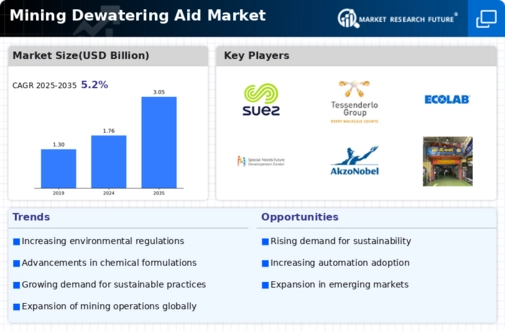Market Growth Projections
The Global Mining Dewatering Aid Market Industry is poised for substantial growth in the coming years. Projections indicate that the market will reach a value of 1.76 USD Billion in 2024 and is expected to expand to 3.05 USD Billion by 2035. This growth is underpinned by a compound annual growth rate of 5.13% from 2025 to 2035. Factors contributing to this growth include increasing demand for efficient water management solutions, regulatory compliance, and technological advancements. The market's trajectory suggests a robust future, driven by the need for sustainable practices and operational efficiency within the mining sector.
Rising Investment in Mining Activities
The Global Mining Dewatering Aid Market Industry benefits from rising investments in mining activities across various regions. As countries seek to exploit their mineral resources, there is a corresponding increase in mining operations, which necessitates effective dewatering solutions. This trend is particularly pronounced in emerging markets where resource extraction is becoming a priority. The influx of capital into the mining sector not only supports the expansion of operations but also drives the demand for dewatering aids. Consequently, this investment trend is expected to contribute to the market's growth trajectory, aligning with the projected increase to 3.05 USD Billion by 2035.
Growing Awareness of Operational Efficiency
Growing awareness of operational efficiency among mining companies significantly impacts the Global Mining Dewatering Aid Market Industry. Companies are increasingly recognizing that effective dewatering is essential for maintaining productivity and minimizing downtime. This awareness drives the adoption of advanced dewatering aids, which can enhance water removal processes and improve overall operational performance. As mining operations strive for greater efficiency, the demand for innovative dewatering solutions is likely to rise. This trend is expected to support the market's growth, with projections indicating a value of 1.76 USD Billion in 2024, as companies prioritize investments in technologies that optimize their operations.
Increasing Demand for Water Management Solutions
The Global Mining Dewatering Aid Market Industry experiences a notable surge in demand for effective water management solutions. As mining operations expand, the need for efficient dewatering systems becomes paramount to mitigate water-related challenges. This trend is particularly evident in regions with high rainfall or groundwater levels, where excess water can hinder mining activities. The market is projected to reach 1.76 USD Billion in 2024, reflecting a growing recognition of the importance of dewatering aids in maintaining operational efficiency. Companies are increasingly investing in innovative technologies to enhance water removal processes, thereby driving the market forward.
Regulatory Compliance and Environmental Concerns
Regulatory compliance plays a crucial role in shaping the Global Mining Dewatering Aid Market Industry. Governments worldwide are implementing stringent regulations to ensure sustainable mining practices, which include effective water management. These regulations often mandate the use of dewatering aids to minimize environmental impact and protect local ecosystems. As a result, mining companies are compelled to adopt advanced dewatering solutions to comply with these regulations. This trend not only enhances operational efficiency but also promotes environmental stewardship, thereby contributing to the market's growth. The emphasis on sustainability is likely to propel the market towards a projected value of 3.05 USD Billion by 2035.
Technological Advancements in Dewatering Techniques
Technological advancements significantly influence the Global Mining Dewatering Aid Market Industry. Innovations in dewatering technologies, such as the development of high-efficiency pumps and advanced filtration systems, enhance the effectiveness of water removal processes. These advancements enable mining companies to optimize their operations, reduce costs, and improve overall productivity. Furthermore, the integration of automation and real-time monitoring systems allows for more precise control over dewatering operations. As the industry embraces these technologies, the market is expected to witness a compound annual growth rate of 5.13% from 2025 to 2035, indicating a robust future driven by continuous innovation.
























